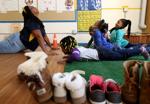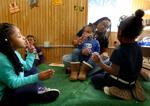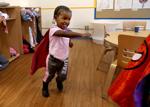JENNINGS — Laura Muhammad's 5-year-old son wonders why she sometimes doesn't eat dinner with him. The single mom doesn't tell him it's because her dinner will be whatever he doesn't finish.
Muhammad's $15-per-hour job as a day care teacher just barely covers her expenses, she said.
"He always eats. I cook his food and hope I'm not that hungry today," said Muhammad, 33, from St. Louis. "Every month I basically have to choose. This is how much money I have. I balance it out and hope nothing comes up."
Now a new St. Louis County program, the first of its kind in Missouri, may temporarily boost her wages. It's an experiment of sorts that aims to use part of a $5.6 million federal COVID-19 relief grant to supplement pay for low-wage child care workers in the county.
It won't be clear how much participants will be eligible to receive until program coordinators finalize details, said Robin Phillips, CEO of Child Care Aware, the organization administering the program in St. Louis County. Details could be finalized sometime in January. In other states, participants have earned up to $1,200 in supplemental wages over six months, depending on their education.
People are also reading…
Muhammad said the extra money will help cover her $400-a-month grocery bills, among other things, at least temporarily.
"At least it'll help us both eat at the same time every day," said Muhammad, who works at Their Future's Bright day care off Jennings Station Road.

Teacher Laura Muhammad leads students Grace Holmes, 3, from left to right,Zahara Strawter, 2 1/2, Mariyah Burns,3, and Chloe Evans, 4, in yoga during circle time on Friday, Nov. 18, 2022, at Their Future's Bright, a non-profit daycare in Jennings. The St. Louis County Council approved the use of $5.6 million in American Rescue Plan Act (ARPA) funds to provide training and pay boosts to daycare workers, Muhummad is one of them. Photo by Laurie Skrivan, lskrivan@post-dispatch.com
Even before the pandemic, child care workers earned much less than the average worker in the United States. In 2019, the average child care worker earned below $14 per hour compared to almost $26 in other occupations, according to the Federal Reserve Bank of St. Louis. At the same time, child care itself is prohibitively expensive to many families: Child care runs an average of $9,000 per year, or 14% of the median household income in the U.S.
Child care worker wages have gone up slightly — the average wage nationwide was just over $16 per hour in fall 2021. It's still well below the living wage as calculated by the Massachusetts Institute of Technology. A single mom like Muhammad living in St. Louis would need to earn about $35.50 an hour to cover food, child care, health, housing and other basic needs, according to MIT's Living Wage calculator.
"My boss doesn't even make that," Muhammad said.
Lucretia Wilks, the director of Their Future's Bright, hopes the program will allow her employees, including Muhammad, to take home some more money so they can continue to serve children in some of the lowest-income parts of St. Louis County. Child care centers may not use the supplement to offset normal wages.
"The state of Missouri requires that teachers teach math, science, social-emotional (learning), gross motor, fine motor," Wilks said. "All that is required in one day from our teachers. ... These are very significant jobs and duties of our teachers, and some are making $11 (per hour)."

Teacher Laura Muhammad reviews sign language with students Chloe Evans, 4, left, Mariyah Burns, 3, center, and Grace Holmes, 3, during circle time on Friday, Nov. 18, 2022, at Their Future's Bright, a nonprofit day care in Jennings.
The new program, called WAGE$, served nearly 9,500 participants in five states in 2021 and 2022, according to data from the Child Care Services Association of North Carolina, where the program started. Its first pilot program had 99 participants in 1994 in a North Carolina county, and it went statewide five years later.
In 2021, the turnover rate of workers enrolled in WAGE$ in North Carolina was 12% compared to 21% in the rest of the industry statewide.
A troubled industry
The COVID-19 pandemic wreaked havoc on the child care system and exacerbated the industry's existing problems.
Day cares closed and faced drastic increases in operating costs, and employees disappeared. From January to April 2020, employment in child care nationwide dropped by 33%, according to the St. Louis Fed. It has bounced back since then, but employment in the industry remained at nearly 7% below pre-pandemic levels as of this summer.
Councilwoman Lisa Clancy of Maplewood sponsored the WAGE$ legislation, and said she supported it because child care workers deserve a break, even if it's temporary.
"This is just a drop in the bucket," Clancy said. "There's a lot of changes we need to make to the system, but it is so fundamental that we invest in workers."
St. Louis County will also use COVID-19 relief dollars for another program designed to support the child care workforce. Missouri already participates in TEACH, which provides scholarships to child care workers to take classes toward their degrees, and then pays them bonuses if they graduate.
Employees aren't the only ones excited about the two programs. Day care owners hope WAGE$ and TEACH will help them keep workers, who might be wooed by easier, better-paying jobs in retail or other sectors. Wilks said she had to increase wages for her teachers because they're not only competing with other day care centers.
"We're competing with Chick-fil-A, with the gas stations," Wilks said.
Muhammad knows she could likely earn more than $20 per hour as a manager at a gas station.
"But I don't want to work at QuikTrip. I want to be a teacher," Muhammad said. "I don't want to struggle just to help others. It's not a fair trade. Teachers should be able to provide while also helping uplift others."

Teacher Laura Muhammad, right, dances with her Mariyah Burns, 3, during circle time on Friday, Nov. 18, 2022, at Their Future's Bright, a non-profit daycare in Jennings. The St. Louis County Council approved the use of $5.6 million in American Rescue Plan Act (ARPA) funds to provide training and pay boosts to daycare workers, Muhummad is one of them. Photo by Laurie Skrivan, lskrivan@post-dispatch.com

Zahara Strawter, 2 1/2, takes flight as Supergirl during free play on Friday, Nov. 18, 2022, at Their Future's Bright, a non-profit daycare in Jennings. Photo by Laurie Skrivan, lskrivan@post-dispatch.com

Grace Holmes, 3, practices her words during circle time on Friday, Nov. 18, 2022, at Their Future's Bright, a non-profit daycare in Jennings. The St. Louis County Council approved the use of $5.6 million in American Rescue Plan Act (ARPA) funds to provide training and pay boosts to daycare workers, Muhummed is one of them. Photo by Laurie Skrivan, lskrivan@post-dispatch.com

Teacher Laura Muhammad leads student Grace Holmes, 3, in yoga during circle time on Friday, Nov. 18, 2022, at Their Future's Bright, a non-profit daycare in Jennings. The St. Louis County Council approved the use of $5.6 million in American Rescue Plan Act (ARPA) funds to provide training and pay boosts to daycare workers, Muhummed is one of them. Photo by Laurie Skrivan, lskrivan@post-dispatch.com

Teacher Laura Muhammad dances on the floor with students Grace Holmes, 3, left, and Chloe Evans, 4, during circle time on Friday, Nov. 18, 2022, at Their Future's Bright, a non-profit daycare in Jennings. The St. Louis County Council approved the use of $5.6 million in American Rescue Plan Act (ARPA) funds to provide training and pay boosts to daycare workers, Muhummad is one of them. Photo by Laurie Skrivan, lskrivan@post-dispatch.com

Teacher Laura Muhammad takes Holding student Mariyah Burns,3, to wash her hands before snack time on Friday, Nov. 18, 2022, at Their Future's Bright, a non-profit daycare in Jennings. The St. Louis County Council approved the use of $5.6 million in American Rescue Plan Act (ARPA) funds to provide training and pay boosts to daycare workers, Muhummad is one of them. Photo by Laurie Skrivan, lskrivan@post-dispatch.com
A selection of photos from 2022 by Laurie Skrivan, who has covered St. Louis from nearly every angle as a Post-Dispatch staff photographer since 1998. She won the 2017 Robert F. Kennedy Journalism award domestic photography and was a member of the 2015 Breaking News Photography Prize awarded to the St. Louis Post-Dispatch photography staff.
"care" - Google News
December 29, 2022 at 04:20AM
https://ift.tt/3pFYZiC
Child care workers get pay boost in new St. Louis County program - St. Louis Post-Dispatch
"care" - Google News
https://ift.tt/fV3qbc0
Shoes Man Tutorial
Pos News Update
Meme Update
Korean Entertainment News
Japan News Update
Bagikan Berita Ini














0 Response to "Child care workers get pay boost in new St. Louis County program - St. Louis Post-Dispatch"
Post a Comment